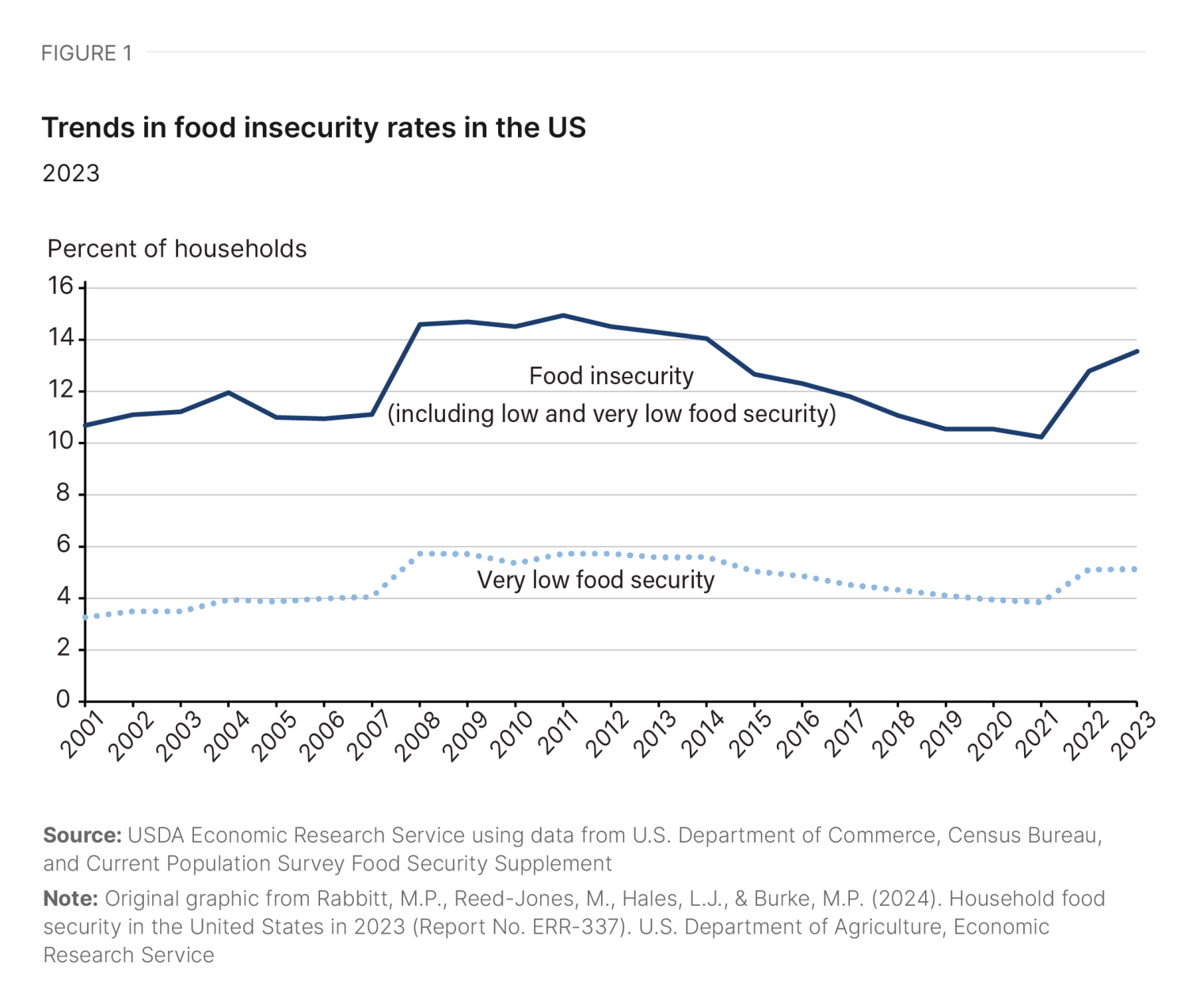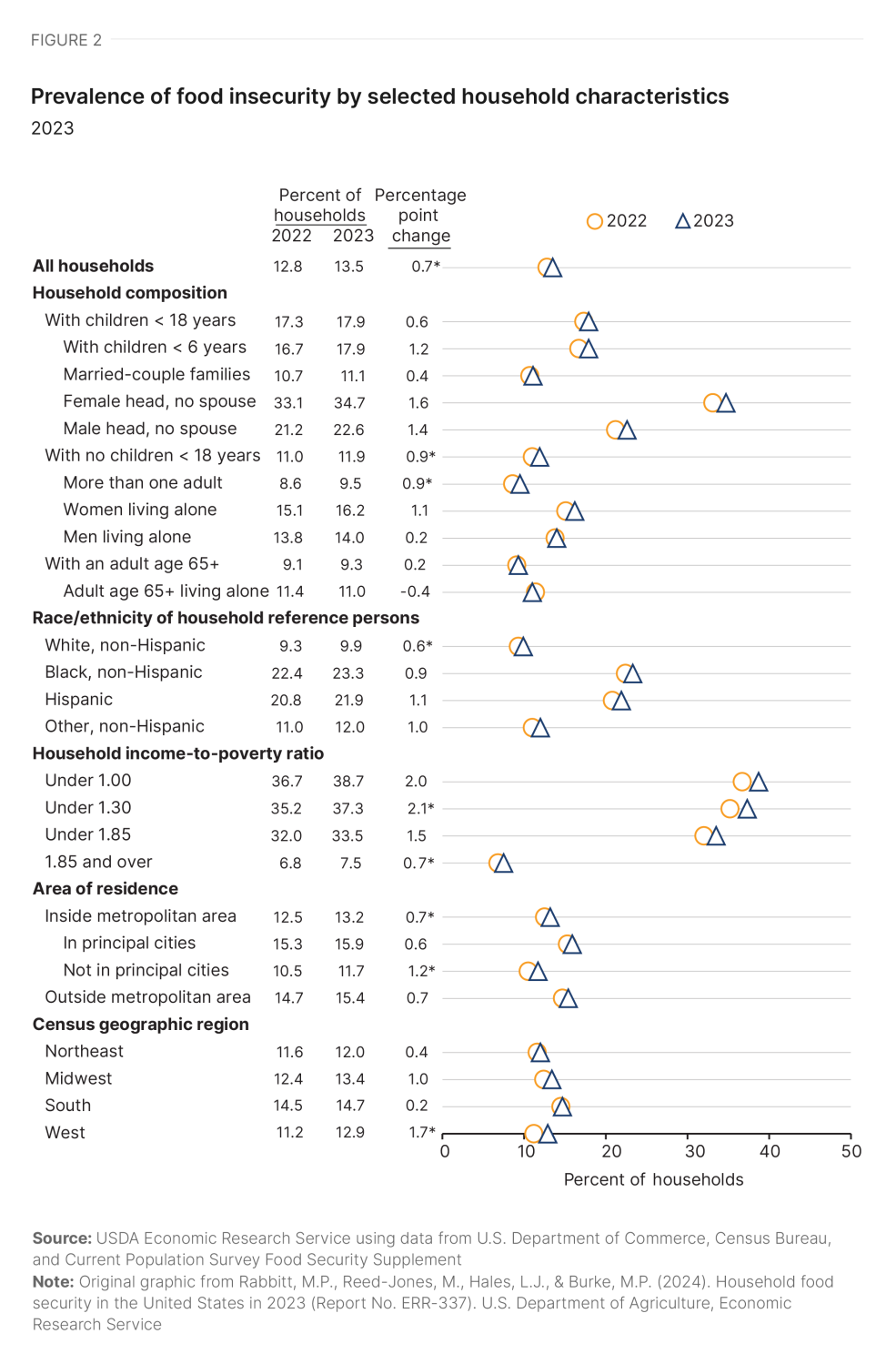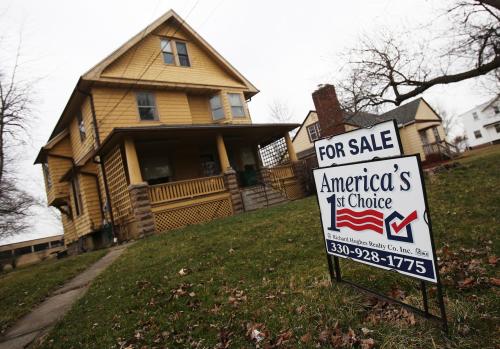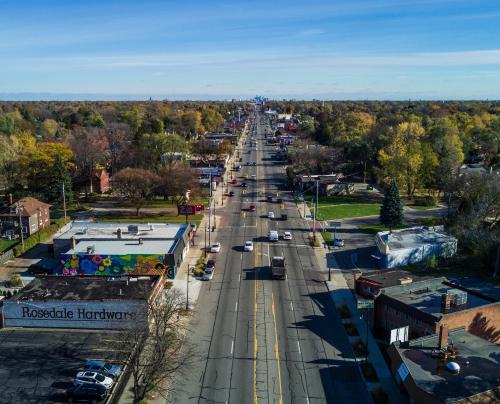The Farm Bill is a critical piece of legislation that reauthorizes the country’s agricultural and nutrition programs about every five years—and the 2024 version is now on legislators’ desks, with some major changes.
Originally designed to support farmers, the Farm Bill has evolved over time to prioritize nutrition assistance, with the Supplemental Nutrition Assistance Program (SNAP) now comprising 76% of the budget—projected to increase to 84% in the current version. This shift underscores the growing emphasis on addressing food insecurity among low-income Americans, as SNAP currently serves over 42 million individuals, or about 12% of the population.
The 2024 Farm Bill will fund SNAP, agriculture subsidies, and crop insurance through 2029, at a projected cost of $1.5 trillion. However, as the first Farm Bill to exceed $1 trillion, it faces heightened scrutiny as both parties clash over the allocation of funding between SNAP, subsidies, and other key programs.
The current version of the bill, introduced by the Republican-led House Agriculture Committee, has sparked controversy by proposing a $30 billion cut to SNAP funding over the next decade. This reduction would be achieved by limiting adjustments to the Thrifty Food Plan (TFP)—a low-cost, standardized estimate of the minimum cost of a nutritious diet, used to determine SNAP benefit levels—to inflation rates only.
The TFP is reevaluated every five years to reflect current food costs. In 2021, the Biden administration reevaluated the TFP to respond to high food costs due to COVID-19 and supply chain issues in the global food industry, resulting in the largest-ever increase in SNAP benefits, totaling $256 billion. Now, Republicans are seeking to restrict future adjustments to reflect only inflation costs, marking the largest SNAP reduction in nearly three decades. But Democrats and researchers argue that such a restriction could have significant impacts on the 42 million SNAP recipients, including 17 million children, 6 million older adults, and 4 million people with disabilities.
Americans face rising food insecurity and barriers in accessing nutritious diets
The proposed cuts, along with provisions to outsource program operations, could undermine SNAP’s ability to effectively combat food insecurity. This is especially concerning given that food insecurity rates rose to 13.5% of U.S. households in 2023, affecting 18 million families—a statistically significantly increase from 2022, according to the U.S. Department of Agriculture (USDA). Food insecurity rates are notably higher for single-parent, female-headed households; Black and Latino or Hispanic households; and households in principal cities and rural areas. In addition, voters are growing increasingly worried about inflation and high food costs, with 70% citing food prices as a major concern. This view is especially pronounced among younger voters, who have been hit hard by a 20% surge in food costs since 2020, as reported by the Bureau of Labor Statistics.
In addition to concerns surrounding food insecurity and rising costs, the TFP debate risks being a superficial fix that overlooks deeper, more critical challenges low-income families face in accessing nutritious diets. A USDA study found that 88% of SNAP participants encounter challenges in maintaining a healthy diet, with 61% citing the high cost of healthy foods as a key barrier. Other reasons include a lack of time to prepare meals at home and transportation difficulties in accessing healthy foods.
Access barriers—combined with broader economic factors such as regional variations in real food prices and other costs of living, shifts in food composition data, changing consumption patterns, and updated dietary guidance—significantly impact low-income households’ ability to maintain affordable, nutritious diets. Addressing such factors is crucial for creating a more sustainable and impactful SNAP program, yet they remain sidelined in favor of quick, inflation-focused approaches that do little to address systemic barriers to healthy food access for vulnerable families.


The proposed $30 billion cut to SNAP funding over the next decade by restricting the USDA’s authority to adjust the TFP beyond inflation rates will have serious and multidimensional challenges for these low-income, food-insecure households. In addition, the bill’s proposal to outsource core SNAP operations to private entities could create complications in the application process and eligibility criteria, while also increasing federal costs by $1 million.
Notably, the current version of the bill proposes to expand SNAP’s purpose to include the prevention of diet-related chronic diseases. Critics, such as the HEAL (Health, Environment, Agriculture, Labor) Food Alliance, argue that this risks diverting attention away from SNAP’s core mission of reducing food insecurity, and instead shifts the focus to diet-related concerns facing low-income populations. Yet these diet-related concerns are often a result of multifaceted challenges such as stress (or “bandwidth poverty”), food insecurity, and other factors such households face. The current version of the bill also proposes to cut climate-focused conservation efforts introduced by the Inflation Reduction Act.
Proposed changes to agricultural subsidies have sparked equity concerns
The proposed Farm Bill aims to reallocate funds by raising price floors for key agricultural commodities such as corn, wheat, and soybeans, while cutting SNAP funding. A large portion of the increased spending is directed toward farm programs and crop insurance—raising concerns about equity and the disproportionate benefits to large, wealthy farms.
A report from the American Enterprise Institute highlights this disparity, revealing that the top 10% of farms receive 56.4% of all crop insurance subsidies, with the top 5% receiving 36.4%. Since these subsidies are not means-tested—and the level of subsidies is directly proportional to an agri-business’s production levels—the wealthiest and largest businesses capture the most significant share of these benefits. Research from the Environmental Working Group confirms evidence on the concentration of these subsidies toward the wealthiest agri-business owners. They found that between 1995 and 2021, the top 1% of recipients received 27% of the total $478 billion in farm subsidies—underscoring the disproportionate benefits to large-scale, wealthy farmers. Moreover, these subsidies favor a narrow range of commodity crops such as corn, soybeans, wheat, and cotton, which accumulates benefits to white, wealthy farmers while farmers of color receive little support. This inequitable allocation of resources raises important questions about the Farm Bill’s broader social and economic implications.
The Government Accountability Office and Congressional Budget Office have proposed reforms to the current inequitable structure of these subsidies. Such reforms have the potential to reduce the fiscal deficit while protecting rights of farmers, ensuring food assistance to low-income populations, and maintaining price levels of key commodities. Reforms include implementing income limits on premium subsidies for wealthy farmers, adjusting compensation for insurance companies to reflect market rates, and reducing taxpayer reimbursements for administrative costs.
SNAP benefits aren’t keeping up with the true costs of a healthy diet
A critical aspect of SNAP that is often overlooked in fiscal policy debates is the economic adequacy of the program’s benefits. There is a growing body of research suggesting that SNAP benefits in their current form are insufficient to cover the “real” cost of a healthy diet.
In other words, the TFP might not truly reflect the real value of food costs low-income households face. The TFP was originally intended to represent the minimum food expenditure basket that would allow low-income households to avoid food insecurity. It is not necessarily based on the most recent scientific methodologies that factor in food prices, accessibility, and dietary needs.
Recent evaluations have shown that the TFP often underestimates the cost of a nutritious diet, particularly in areas with higher living costs. An Urban Institute study found that despite food price inflation moderating in 2023, SNAP benefits remained inadequate for covering food costs: By the end of 2023, the average modestly priced meal cost $3.37, which was 19% more than the average maximum SNAP benefit of $2.84. Families with zero net income faced a shortfall of $49.29 per month by the end of the year, with urban areas experiencing a 28% gap between meal costs and SNAP benefits, compared to 17% in rural areas. In the five counties with the largest gaps, the shortfall exceeded 70% throughout the year.
Recent economic research indicates that current SNAP benefits often fall short of covering the actual cost of a low-budget, healthy diet, with significant variations in benefit adequacy across U.S. regions. Researchers have found that these geographic variations in SNAP purchasing power significantly affect welfare outcomes such as child health and food insecurity. Despite deductions for housing and child care, many regions face much higher real costs of food, and SNAP dollars do not go far in such high-cost areas. To ensure equitable support, social scientists have put forth proposals to index SNAP benefits to local area food prices.
Therefore, the proposed cuts to SNAP funding risk exacerbating systemic and multidimensional challenges low-income populations already face. Concerns about food insecurity and diet-related chronic diseases are symptomatic of deeper systemic challenges related to health insurance access, stress and bandwidth poverty, access to healthy foods, the higher cost of healthy foods, and structural oligopolies in the American food industry. Research suggests that SNAP inadequacy is linked to worse health outcomes, such as increased risk of obesity, diabetes, and hypertension. Yet instead of focusing on deeper systemic issues, the current Farm Bill proposes a quick fix, Band-Aid solution by proposing to cut SNAP funding further.
Policy recommendations for a stronger Farm Bill
Despite proposing massive cuts to SNAP, increasing inequitable farm subsidies, and cutting climate funding for conservation efforts, the 2024 Farm Bill does lay out some positive measures. These include raising the income cutoff for SNAP eligibility (the Earned Income Deduction) from 20% to 22% of income, which will ensure more households just at the margin of earned income now have access to SNAP benefits. It proposes to give benefits access to individuals with drug-related convictions, who were previously excluded. Further, it proposes to extend the age limit for high school students on SNAP from 18 to 22 years, allowing students to work without disincentivizing income for eligibility. However, despite these positives, the proposed cuts and other changes could undermine the Farm Bill’s effectiveness in addressing food insecurity and equity concerns in agricultural subsidies.
The proposed cuts based on restricting SNAP increases to only reflect inflation diverge significantly from academic research underscoring that the TFP should be updated regularly to factor in food prices, consumption patterns, and nutritional guidelines. While this measure could save $29 billion between 2025 and 2033, it will further dampen SNAP’s purchasing power as food costs continue to rise and vary across regions.
The polarization of the Farm Bill reflects a broader ideological divide over the role of welfare in American society. Republicans have historically advocated for limited assistance and stricter work requirements for SNAP recipients. In contrast, Democrats have historically perceived welfare programs such as SNAP as essential tools for reducing poverty and inequality, and advocated for expanded benefits and more coverage.
Politicians need to look beyond this ideological gap and focus instead on creating a more equitable and effective Farm Bill that addresses society’s economic and welfare needs. A zero-sum approach that pits agricultural interests against the needs of food-insecure, low-income consumers is not proving to be effective.
What follows are key policy recommendations for crafting an inclusive and equitable Farm Bill that addresses the economic and welfare needs of vulnerable populations, including low-income households and underrepresented farmers.
- Evidence-based SNAP adjustments: Use scientific methodologies to measure the TFP’s adequacy and issue frequent and regular updates to SNAP benefits. Factors that impact the TFP beyond inflation include other costs of living, regional variations in SNAP adequacy, food consumption patterns, and healthy diet guidelines.
- Index benefits to reflect local economic conditions: Implement regional cost-of-living adjustments to SNAP benefits, which can address disparities in food costs and improve equity across geographic regions.
- Expand access to healthy foods: Invest in initiatives that improve access to healthier food options, such as affordable farmers markets, community gardens, and incentives for retailers in underserved areas to improve food access and support local economies.
- Rebalance agricultural subsidies: Impose income limits on farm subsidies and expand efforts to improve subsidy access for small-scale and BIPOC farmers.
- Integrate climate goals: Allocate funding for climate-resilient agricultural practices and provide financial assistance and incentives to small-scale and BIPOC farmers to invest in such technologies.
- Foster bipartisan collaboration: Encourage cooperation across party lines to create a Farm Bill that balances agricultural support with food assistance—recognizing their interdependence rather than treating them as competing interests.
- Engage stakeholders: Involve farmers, nutrition advocates, and SNAP recipients in the legislative process to ensure policies reflect the needs and realities of those directly impacted.
The 2024 Farm Bill represents a critical opportunity for Congress to craft a more equitable and inclusive policy that addresses the dual needs of supporting agricultural production as well as nutrition assistance. However, as it currently stands, proposals such as the $30 billion cut to SNAP funding, the shift in focus toward preventing diet-related diseases, and the continued expansion of agricultural subsidies that disproportionately benefit white, wealthy farmers and a limited number of commodity crops risk undermining SNAP’s response to food insecurity and worsening inequality in the agriculture sector.
Policymakers must look beyond zero-sum dynamics that pit agricultural subsidies against nutrition assistance, when the fundamental issues farmers and low-income households face are symptomatic of deeper systemic inequalities in the economic and welfare structures of fiscal policy. Therefore, rather than continuing to concentrate support in the hands of wealthy, large-scale agricultural producers, the Farm Bill should prioritize uplifting smaller, diverse farmers and ensuring low-income households have the resources they need to access nutritious food. Encouraging small-scale and low-income BIPOC farmers to invest in green technology is also essential, as this would foster more sustainable agricultural practices while supporting communities’ economic growth. At the same time, Congress must ensure that commodity prices remain stable and affordable, preventing further economic burdens on consumers.
An equitable and welfare-focused Farm Bill would embrace a broader vision—one that balances the needs of both rural farming communities and urban, food-insecure families. By aligning agricultural subsidies with sustainable practices and expanding SNAP’s effectiveness, Congress can craft a policy that not only strengthens food security, but also builds a more just, resilient, and environmentally responsible food system for all Americans.




